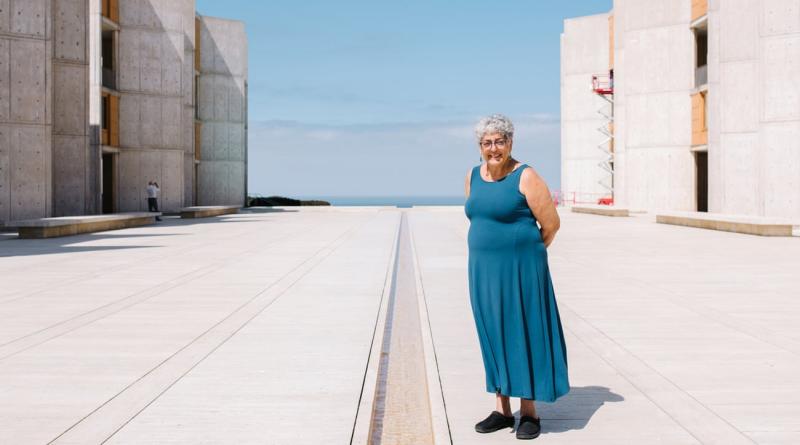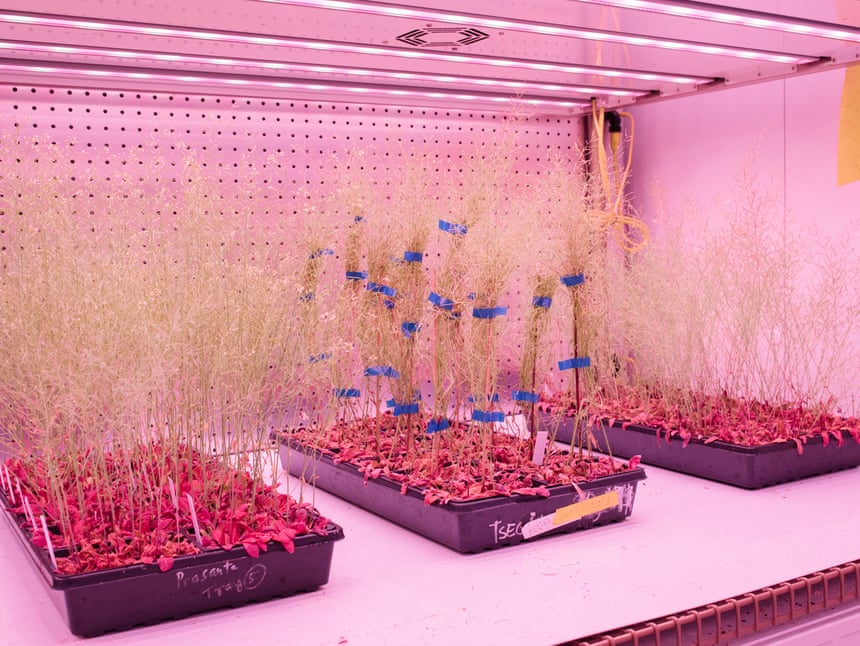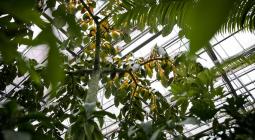This scientist thinks she has the key to curb climate change: super plants.

Dr Joanne Chory hopes that genetic modifications to enhance plants’ natural carbon-fixing traits could play a key role – but knows that time is short, for her and the planet.
If this were a film about humanity’s last hope before climate change wiped us out, Hollywood would be accused of flagrant typecasting. That’s because Dr Joanne Chory is too perfect for the role to be believable.
The esteemed scientist – who has long banged the climate drum and now leads a project that could lower the Earth’s temperature – is perhaps the world’s leading botanist and is on the cusp of something so big that it could truly change our planet.
She’s also a woman in her 60s who is fighting a disease sapping her very life. In 2004, Chory was diagnosed with Parkinson’s, which makes the timetable for success all the more tenuous.
“We’re trying to do something that’s a huge, complicated thing even though it sounds so simple,” Chory says. “Plants evolved to suck up CO2 and they’re really good at it. And they concentrate it, which no machine can do, and they make it into useful materials, like sugar. They suck up all the CO2, they fix it, then it goes back up into the atmosphere.”
She is now working to design plants capable of storing even more carbon dioxide in their roots. Her Ideal Plant project uses gene editing – via traditional horticulture and Crispr – to do so. On a large scale, this could suck enough carbon out of the atmosphere to slow down climate change.
This concept basically splices the genes of regular crops and everyday plants like beans, corn and cotton, with a new compound that makes them absorb more carbon. Their roots then transfer it to the soil to keep it there.
This approach essentially supercharges what nature already does.
“I get worked up when I talk about the project,” Chory tells me in an office at the Salk Institute, a revered bio research campus at the edge of the Pacific Ocean in southern California. Her desk is full of posies, awards, family photos and framed magazine covers from science journals. “We have to find a way to take CO2 out of the atmosphere and I think plants are the only way to do that affordably,” Chory says.
“I feel like I have the weight of the world on my shoulders,” she says, letting out a laugh. “It is a lot of pressure.”

Born in Boston to Lebanese parents, the third of six children, Chory received a PhD studying photosynthetic bacteria at the University of Illinois. She spent her postdoctoral years as a Harvard Medical School researcher, then joined the institute in 1988. Along the way, she’s discovered how plants respond to everything from light and environment to how they regulate size and growth.
“It’s a philosophical issue, too,” she says, explaining why so many kick the can of global warming. “If I take pain now, maybe my great-grandchildren might see a benefit. People choose no pain now, that’s why we’ve done nothing about climate change.”
Every now and then as we speak, Chory’s symptoms pop up like an uninvited guest, another stark reminder of time. Struggling to maintain control and ever aware of the implied humor in her movements, she doesn’t shy from the elephant in the room.
“When I get excited I really get moving,” she mock-apologizes, letting out a coy chuckle. “I’m a lot better on Saturdays.” She pauses, collects her thoughts. “That’s why I want to do something that won’t cause pain to people. You never know when you’re making a global change. I don’t know if we can do it, but we have to try.”
An ‘even if’ scenario
Temperatures are already at alarming levels even if we reach the Paris agreement of curbing a rise of 2C. The world is headed for major upheaval, it’s merely a question of the scale. If we have any chance as a species, Salk contends, it’s with big ideas like this.
Right now, the institute is negotiating with seed companies and prepping tests on nine agricultural crops to introduce Ideal Plants on farms around the world. Field-testing begins later this year with wheat, soybeans, corn and cotton.
Developing these Ideal Plants is step one in the Harnessing Plants Initiative, which amplifies root systems and production of suberin – which is essentially cork, or the rind on your cantaloupe, the magic key to plants holding more of that carbon – before transferring these genetic traits to row and cover crops. Given the right resources, and funding, prototypes of each crop are expected to be ready in the next five years.
A $2m gift by Howard Newman, a Salk board member and private equity veteran who has invested in oil and gas, jump-started the project last June. In April, Salk received a TED Audacious grant totaling $35m to support the plan.
Chory says these new plants will have deeper and stronger root systems that will also stop erosion, another byproduct of warming temperatures, which will make soil more healthy and boost production. When normal plants die, they release large amounts of CO2 back into the air; when Ideal Plants die, significantly less CO2 will be re-released due to more carbon being stored in deeper roots and soil for longer periods, and suberin’s natural ability as a carbon polymer to resist short-term decomposition.
The first two meters of the Earth’s soil holds over three times the amount of carbon as the atmosphere, and can hold even more. Fossil fuel use was predicted to rise nearly 2% last year. Each year, we produce 18 more gigatons of CO2 than the Earth can currently handle; Salk believes their solution can achieve as much as a 46% annual reduction in excess CO2 emissions produced by humans.
It’s an extremely ambitious idea full of so many unknowns – how to get global buy-in from farmers, how many years will it take for plants to reach maturity and will it then be too late, how will mother nature react to such genetic modification and how will these crops taste – that none of Salk’s brains have the answers to.
The institute was founded in 1960 by Jonas Salk, a biologist who discovered the cure for polio in 1955, two years before my own father’s identical twin died of the disease in communist Romania, a place where politics kept science at bay.
Standing at the edge of the seaside campus designed by Louis Kahn, a sprawl of ominous cement towers and dramatic ocean views, it all feels straight out of the mind of Philip K Dick. Part Gattaca, part Logan’s Run, it’s easy to see why numerous films have been shot here.
But there’s also an optimism in these labs that feels so far from the stark structures and climate narrative I’m used to. Many scientists have told me their role is something akin to historian, documenting the last days of a species or system. Not so here.
“There is hope in dreams, in imagination and in the courage of those who dare to make dreams into reality,” Jonas Salk once said.
Inside these modernist blocks, they’re dreamers too, but rooted in reality. The biological research center, funded by government grants and private donors, has spent decades inching towards cures for everything from cancer to Alzheimer’s. In 1968, Robert W Holley, Salk Cancer Center’s founding director, won a Nobel prize; in 1975, Institute staff won another Nobel, and again in 1977 and 2002.
More recently, Chory was awarded a $3m breakthrough prize for discovering how plants optimize their growth, development and cellular structure to transform sunlight into chemical energy.
I see the optimism on a tour with Dr Joseph Noel, a biochemist focused on harnessing suberin, the project’s linchpin. He shows me seed-planting robots, which can bang out a day’s work in the time it would take a human weeks; state-of-the-art grow rooms capable of simulating almost any environmental condition; greenhouses sitting atop dramatic bluffs. All the while he breaks down the importance of cork. “It’s a spongy barrier that helps a plant regulate water coming in and out, gas exchange coming in and out. Think of it like a protective plastic around certain cells in the plant.”
The institute’s founder, Jonas, once said “our greatest responsibility is to be good ancestors,” and I think about the quote’s relevance as Noel shows me rows of simulation rooms full of cattails, marsh grasses, Lotus japonicuslegumes and weed-like Arabidopsis thaliana, all in various states of growth as LEDs shine and humid air blasts while I take notes.
“Instead of just growing in a greenhouse or artificial lights in a lab, we wanted to have the ability to simulate a particular climactic zone: quality of light, seasonal changes, cloud cover, temperatures,” Noel says.
Since Arabidopsis “can go from seed to seed in six weeks” and its genome is entirely sequenced and resembles so many other species, the little mustard flower has become the project’s veritable Rosetta Stone.
“It’s very easy to change the genetics of it on a massive scale,” he continues. “If we change a particular gene, we can find out if the roots get deeper, do they get more extensive, does the suberin content change. Their early ancestors have been doing photosynthesis for about 2.8bn years.”
Without plants, life as we know it wouldn’t exist. The question is whether these ones will become our saviors.
Genetically modified plants remain a tough sell
There’s a growing field of carbon dioxide removal projects which include machines pulling C02 out of the sky, known as direct air capture. There’s Bill Gates-backed Carbon Engineering and the Zurich startup Climeworks, and about 20 commercial carbon capture and storage facilities worldwide, but they’re price prohibitive.
There have been notable failures: Sir Richard Branson tried a $25m prize for carbon removal but never found a solution. Carbon removal initiatives are also criticized for preserving the status quo and big energy business models.
“Ultimately, we all know that humanity’s response to climate change will, as the Ideal Plant project states, make or break our future,” says David Stern, the president and CEO of the Boyce Thompson Institute, a leading plant research facility in New York, who calls Chory a fearless, creative and open-minded scientist. “Given the complexities and scale of the problem, many types of solutions will be needed. Sequestration is undoubtedly one of them.”
One big problem, Stern notes, is winning hearts and minds. Genetically modifying organisms saving the planet might be a tough sell in an era when GMO has become the antithesis for the green, organic movement.
“While they are not proposing traditional transgenic lines nor are they proposing to do their work in food crops, the issue will still come up,” Stern adds.
Chory maintains that plants have been modified for millennia – selecting the best strains to cultivate and taking a hand in their development is a form of genetic modification, after all – and the nutritional and yield values of such tweaked products still outweigh the drawbacks. Salk doesn’t introduce foreign genetic material in its plants, unlike many GMO products. The European Union outlawing modified organisms, plus crops with Crispr traits (as a result, the plants might not make it to the EU). Another issue is seed pricing and getting it to farmers around the world, so the wide-scale use is in question.
“As with any GMO crop the big question is how do the changes affect nutritional quality and whether small farmers in developing countries would be able to buy the seeds on a large enough scale to make a difference?” wonders Dan Wenny, a senior biologist who studies land-bird seed dispersal at the San Francisco Bay Bird Observatory.
Right now, the Mississippi delta in Louisiana is a test zone for a first batch of Ideal Plants in the wild, a major step to see if improved root systems can mitigate sea level rise. Still, Salk researchers are sober to the odds.
“Any restoration effort, unlike our Arabidopsis that can grow from seed to seed in six weeks, these systems you plant them and then you wait. You wait a long time,” Noel laments. “We can’t afford to have these experiments not work.”
Are we past the point of no return? “The world’s not going to be the world we live in right now,” Chory says. “I don’t know if we’re going to eliminate the whole human species, but I think if we don’t do something soon we will go that route. The misery index of humidity plus the heat will get so high mammals can’t live.”
The Union of Concerned Scientists says the tipping point is here.
“I don’t think it’s here yet,” Chory counters. Still, she concedes that “migration is already happening. Canada is going to make out well in this. The United States is not. We’re going to have a lot of changes in our agriculture.”
She adds: “The farmers are the ones we really have to convince. We can’t continue to farm the way we farm any more. It can feed 8 to 10 billion people but 50 years from now, there won’t be any good soil left so you’re just putting the disaster off.”
Chory glances at a picture of her daughter, Katie.
“Look at me, I’m 64 years old. I’m not going to be around to see this project go to fruition, I’m not going to be working at Salk, probably. That urgency is there. The climate urgency is there. Every week there’s a new climate disaster. How can we get there? We can’t really get there any faster. I don’t know if we can do it, but I want to be part of the solution. I don’t just want to sit around and complain.”
Adam Popescu is a Los Angeles writer. His debut novel, Nima, will be published on 21 May
17 April 2019





